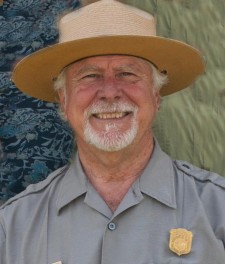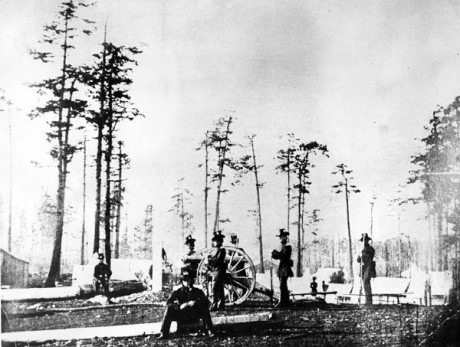Mike Vouri on KPLU Radio Saturday
Posted April 9, 2015 at 5:50 am by Tim Dustrude
The Pig War crisis of 1859 will get an airing out with San Juan Island National Historical Park’s historian, Mike Vouri, on KPLU Public Radio’s “Sound Effect” program, scheduled doe 10 a.m., Saturday April 11.

Mike Vouri – Contributed photo
Vouri was interviewed Tuesday at American Camp by the program’s host, Gabriel Spitzer. KPLU is an FM channel at 88.5 on the dial. The program also can be streamed live by going to http://kplu.org/listen-live. Recordings of the broadcast can be heard in the Sound Effect archive at this link, or by subscribing to the program’s Podcast at this link.
“It is always a challenge to boil down the Pig War crisis and joint military occupation to about 15 minutes of programming, especially when you’ve been telling that story for more than 20 years,” said Vouri, who is also the park chief of Interpretation. “The key is always returning to primary lesson of the story — that peace broke out instead of war here – because that’s what this park is all about.“
The seemingly innocuous act of shooting a pig that had strayed into a garden nearly escalated into hostilities between elements of the U.S. Army and the Royal Navy on San Juan Island between July and October 1859. The crisis was quelled thanks to the restraint of Royal Navy officers on scene and the negotiating skills of Lt. General Winfield Scott, commander of the U.S. Army, who made the six-week trip from New York City to the West Coast from Washington, DC.
Shortly after Scott re-embarked for the East, the two nations agreed to a joint military occupation of the island. The Americans elected to remain at their camp on the island’s Cattle Point Peninsula while Royal Marines established their camp 13 miles north on Garrison Bay.
Throughout the joint occupation the garrisons exchanged visits to celebrate holidays that included Christmas, the Fourth of July and Queen Victoria’s birthday. Typically the men would participate in athletic contests, imbibe in spirits and other refreshments and usually host a dance to which the community was invited.
The incident led to the creation of San Juan island National Historical Park by Act of Congress in 1966. The park bill was signed into law by President Lyndon B. Johnson. The park today is composed of 2,141 acres at its American Camp and English Camp units. In addition to the respective parade grounds and historic structures, the park also has a significant natural resource including eight miles of saltwater shoreline, native prairie, conifer forests and rocky uplands. More than 250,000 visit annually from throughout the nation and world.
Vouri is the author of The Pig War: Standoff at Griffin Bay (Discover Your Northwest/University of Washington Press, $18.95), a history of the incident now in second edition and its 16th year in print.
“The second edition has about 100 more pages of narrative and notes that contain much of what I’ve learned since the first edition went to press” Vouri said. “Just when you think you know it all another fact turns up. It happened after the second edition was published. But you’ll have to wait for the third edition to read that.”
–NPS–
You can support the San Juan Update by doing business with our loyal advertisers, and by making a one-time contribution or a recurring donation.
Categories: Around Here











No comments yet. Be the first!
By submitting a comment you grant the San Juan Update a perpetual license to reproduce your words and name/web site in attribution. Inappropriate, irrelevant and contentious comments may not be published at an admin's discretion. Your email is used for verification purposes only, it will never be shared.